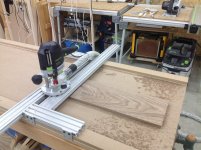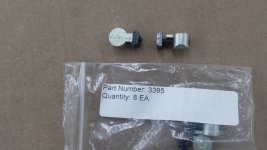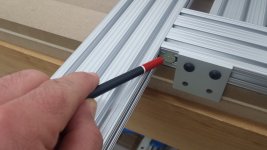You are using an out of date browser. It may not display this or other websites correctly.
You should upgrade or use an alternative browser.
You should upgrade or use an alternative browser.
Flattening a wood plank glue up
- Thread starter donwon
- Start date
ear3
Member
- Joined
- Jul 24, 2014
- Messages
- 4,341
I usually start with Granat 80 for something like this, assuming there is minimal misalignment between the panels. If the boards are really rough, I might even move down to 60, but carefully, since this paper on the Rotex eats through wood like nobody's business. If there is a fair amount of glue residue, it might be good to work the joint first with a scraper or block plane to get off the excess, an d so save the paper and protect against dishing from pressing the sander too hard.
If there are significant ridges, then be careful about going all out with the Rotex, as this will create depressions in the panel.
If there are significant ridges, then be careful about going all out with the Rotex, as this will create depressions in the panel.
Tayler_mann
Member
- Joined
- Nov 23, 2014
- Messages
- 416
24" Oliver wide belt sander... [big grin]
Kidding I just make sure my pieces are flat before I glue than finish with 180 grit and 220 before stainingr
Kidding I just make sure my pieces are flat before I glue than finish with 180 grit and 220 before stainingr
Carl Prentiss
Member
- Joined
- Jan 3, 2013
- Messages
- 365
I agree with Svar from middle earth!
Birdhunter
Member
- Joined
- Jun 16, 2012
- Messages
- 4,144
I rely on my ancient drum sander to flatten glued up panels. Mine is limited to 16" with the option of turning the panel 180 degrees and getting about 32" sanded.
I have taken larger panels to my Woodcraft store. One of the staff has access to a really big drum sander. For a few dollars, I get a perfectly flat panel that I can finish sand.
I have taken larger panels to my Woodcraft store. One of the staff has access to a really big drum sander. For a few dollars, I get a perfectly flat panel that I can finish sand.
erock
Member
- Joined
- Apr 29, 2010
- Messages
- 1,251
I made this jig with 80/20 profiles.
I have 2 glue ups of maple for doors that I have to flatten. I only have a 12" plainer and the panels are 19" wide.
OF1400 with 30mm template guide. 1" Freud bit. I have a 1-3/4" Freud bit being delivered tomorrow. It will make the process a little quicker.
[attachimg=1]
Eric
I have 2 glue ups of maple for doors that I have to flatten. I only have a 12" plainer and the panels are 19" wide.
OF1400 with 30mm template guide. 1" Freud bit. I have a 1-3/4" Freud bit being delivered tomorrow. It will make the process a little quicker.
[attachimg=1]
Eric
Attachments
Stephen B
Member
- Joined
- May 6, 2013
- Messages
- 2,749
Some basics prior and during the glue up also assist: square jointing, alternating top and bottom clamps and even at times using cauls.
http://www.finewoodworking.com/how-to/video/how-to-make-cambered-cauls.aspx
http://www.finewoodworking.com/how-to/video/how-to-make-cambered-cauls.aspx
erock said:I made this jig with 80/20 profiles.
I have 2 glue ups of maple for doors that I have to flatten. I only have a 12" plainer and the panels are 19" wide.
OF1400 with 30mm template guide. 1" Freud bit. I have a 1-3/4" Freud bit being delivered tomorrow. It will make the process a little quicker.
[attachimg=1]
Eric
Eric, for a moment, I thought those were MFS profiles in the picture! Nice idea for using the 80/20 material.
Mike A.
erock
Member
- Joined
- Apr 29, 2010
- Messages
- 1,251
mike_aa said:erock said:I made this jig with 80/20 profiles.
I have 2 glue ups of maple for doors that I have to flatten. I only have a 12" plainer and the panels are 19" wide.
OF1400 with 30mm template guide. 1" Freud bit. I have a 1-3/4" Freud bit being delivered tomorrow. It will make the process a little quicker.
[attachimg=1]
Eric
Eric, for a moment, I thought those were MFS profiles in the picture! Nice idea for using the 80/20 material.
Mike A.
[member=30413]mike_aa[/member]
Yeah Mike, the 80/20 is nice. I have 4 different length that I use just like the MFS profiles.
rvieceli said:Eric try the last couple of passes with the grain (so lengthwise) to minimize tear out.
[member=3192]rvieceli[/member]
Yes Sir. I do the last two passes with the grain. It's quicker going against the grain for the first few passes. And with using the OF1400 and ability to micro adjust the depth by 1/10mm ( 1/256") the last couple passes leaves very little to finish with a sander.
erock said:I made this jig with 80/20 profiles.
I have 2 glue ups of maple for doors that I have to flatten. I only have a 12" plainer and the panels are 19" wide.
OF1400 with 30mm template guide. 1" Freud bit. I have a 1-3/4" Freud bit being delivered tomorrow. It will make the process a little quicker.
[attachimg=1]
Eric
Hi Eric
One question I do have about this setup is what connectors did you use to join the pieces together. From the pics it is hard to tell. More pics would be helpful! Thanks!
Birdhunter
Member
- Joined
- Jun 16, 2012
- Messages
- 4,144
How do you hold the workpiece to the bench whilst it's being flattened?
bdiemer
Member
- Joined
- Mar 18, 2014
- Messages
- 196
As you know traditionally it's done with one dog in the bench and another in the end vise, but the above system would work with double face tape.Birdhunter said:How do you hold the workpiece to the bench whilst it's being flattened?
erock
Member
- Joined
- Apr 29, 2010
- Messages
- 1,251
donwon said:erock said:I made this jig with 80/20 profiles.
I have 2 glue ups of maple for doors that I have to flatten. I only have a 12" plainer and the panels are 19" wide.
OF1400 with 30mm template guide. 1" Freud bit. I have a 1-3/4" Freud bit being delivered tomorrow. It will make the process a little quicker.
[attachimg=1]
Eric
Hi Eric
One question I do have about this setup is what connectors did you use to join the pieces together. From the pics it is hard to tell. More pics would be helpful! Thanks!
[member=18132]donwon[/member]
I used 80/20 10 series. 3" wide. 2 are 36" long. 2 are 12" long. Here are the connectors I used.....
[attachimg=1]
[attachimg=2]
[member=15289]Birdhunter[/member]
double sided woodworking tape.
Eric
Attachments
Holmz
Member
- Joined
- Oct 11, 2014
- Messages
- 4,001
erock said:...
I used 80/20 10 series. 3" wide. 2 are 36" long. 2 are 12" long. Here are the connectors I used.....
...
Eric
I am a bit today (coffee in hand).
Where does that extrusion come from?
That looks pretty slick.
Similar threads
- Replies
- 5
- Views
- 1K
- Replies
- 7
- Views
- 391



